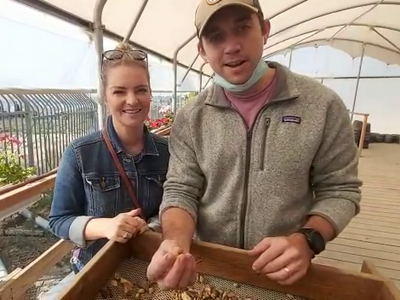Find and Finder of the Month: Ivory Legs Found by Lev Simcha Levi
It has been quite challenging over the past year to keep posting a Find of the Month article each on a consistent basis, considering the slow pace of the sifting due to the numerous lockdowns and Covid-19 regulations and restrictions. In recognition of our staff members’ perseverance in continuing the sifting by themselves, despite the somewhat desolate atmosphere devoid of visitors, this month’s article is dedicated in their honor. This month’s find illustrates the important interplay between the field and the laboratory, as with all archaeological digs. Attention in the field is concentrated on ensuring that not one artifact goes unnoticed, and so staff members don’t necessarily manage to scrutinize each artifact in depth (especially true for the smaller artifacts). Only afterwards, during slow and painstaking work in the lab, do we manage to add quality to quantity in checking over the finds. The ‘Finder of the Month’ chosen this time is one of our rank, Lev Simcha Levi, who joined the sifting when it reopened in its new site at Mitspeh HaMasu’ot. Lev has hands of gold, and you can see his repair-work and creations all over the sifting site. While checking over the sifting nets, Lev discovered a tiny object, partly charred, about 1 cm in height and made of ivory. It appears that its original height was double the size, but it broke somewhere in the mists of time.

One can make out a pair of legs, and by their side is a small post; it looks as if the figure is resting on it, in imitation of well-known poses in classical monumental sculpture. A nice and pretty object, which was waiting to make its way in due course into the archive box of figurines. Until one of our researchers happened to glance on its underside and noticed a break in the base of the tiny figure. In an instant, the object was transformed from a stand-alone manikin to the head of an entirely different object – a hairpin. Pins made of various materials have been widespread for thousands of years in our region, and indeed worldwide, and served various uses – from the entirely practical, such as fastening pins to secure garments, to the entirely ornamental.
Our pin, expertly crafted from ivory, was apparently a hair pin from the Roman-Byzantine era. The pin would have been jabbed into a woman’s hair, perhaps to style it, but it also stood as an ornament in its own right. An example of an intact piece, found in Dora Europus Syria, can give us an idea of how the original pin looked; although, obviously, the carved figure in our pin is quite different. Pins bearing an entire figure are relatively rare in our region – generally simpler ornamentations are found, or the shape of a head alone. Because of the object’s condition today, we can’t determine with any certainty whose figure the craftsman attempted to portray – but from the feminine shape of the legs and the lack of clothing we can conjecture that this is an image of Venus, the Roman goddess of love.
In the Temple Mount Sifting, many fragments of Roman hairpins have been discovered. Most of them have simple designs and do not bear figurines, but more interesting than the actual hairpins is the large quantity of waste remaining from the manufacturing process of the pins. We have found evidence of a workshop of bone items that operated on the Temple Mount during the Late Roman Period. Remains of manufacturing waste from these pins often include bone shaft ends fashioned on a lathe, that were cut off on completion of the formation of the pin design (see below for an example of such an item, recently discovered by Haim Sander). In addition to the cut-offs of hairpins, an impressive number of sawn bones has been discovered – that is to say, bones which have a smoothed and straightened side resulting from being cut by a saw. These cut bones could also have originated in the bone workshop that once operated on the Temple Mount. The following finders and finds are presented in honor of the recent sifting participants who hurried and booked with us as soon as we were again able to accept visitors:

Jasmine Frank from Nes Tziyona discovered an inscribed glazed tile that originated on the Dome of the Rock. 
Chaim Sander discovered a manufacturing scrap of a Roman Era Hair Pin. 
Jay and Madeleine Reilly discovered a beautifully formed mother of pearl bead. 
A stone scale weight of the First Temple Period discovered by Shion Kawai from the Japanese embassy in Israel together with his son.
Discover more from The Temple Mount Sifting Project
Subscribe to get the latest posts sent to your email.












Leave a Reply
Want to join the discussion?Feel free to contribute!